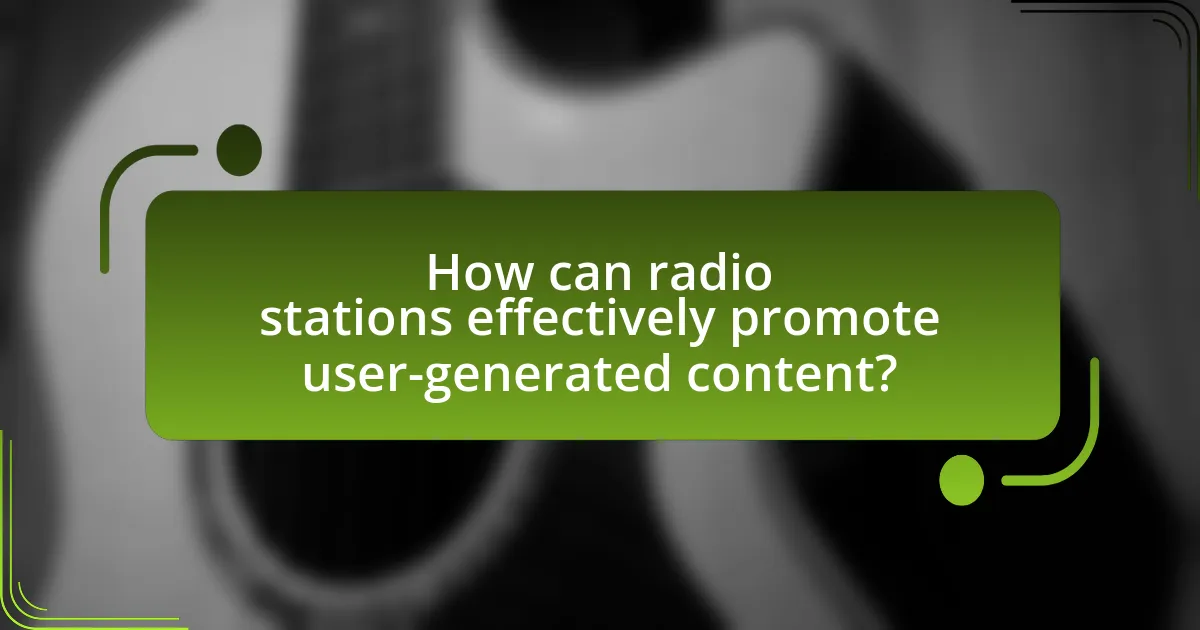Integrating user-generated content into radio programming involves incorporating listener-created material, such as audio clips and social media interactions, to enhance audience engagement and foster community. This practice has been shown to increase listener loyalty and satisfaction, with research indicating that a significant percentage of audiences appreciate having their contributions featured. The article explores the types of user-generated content commonly used, the benefits and challenges of integration, and strategies for managing quality and legal considerations. Additionally, it discusses the role of technology and social media in promoting user participation and the best practices for creating a community around user-generated contributions.

What is Integrating User-Generated Content into Radio Programming?
Integrating user-generated content into radio programming involves incorporating material created by listeners, such as audio clips, social media posts, or feedback, into the broadcast. This practice enhances audience engagement by allowing listeners to contribute their voices and perspectives, fostering a sense of community. Research indicates that radio stations that utilize user-generated content can increase listener loyalty and interaction, as evidenced by a 2021 study from the Pew Research Center, which found that 65% of listeners appreciate when their input is featured on air.
How does user-generated content enhance radio programming?
User-generated content enhances radio programming by increasing audience engagement and fostering a sense of community among listeners. This interactive approach allows listeners to contribute their own stories, music, and opinions, which can lead to more diverse and relatable content. For instance, a study by the Pew Research Center found that 64% of social media users engage with content that reflects their personal experiences, indicating that user contributions can resonate more deeply with audiences. Additionally, incorporating user-generated content can help radio stations adapt to listener preferences in real-time, making programming more relevant and appealing.
What types of user-generated content are commonly used in radio?
Common types of user-generated content used in radio include listener call-ins, social media interactions, and audience-generated music playlists. Listener call-ins allow audiences to share opinions or stories, fostering engagement and community. Social media interactions, such as tweets or posts, enable listeners to contribute ideas or feedback in real-time, enhancing the show’s relevance. Audience-generated music playlists, often curated through listener votes or submissions, reflect the preferences of the audience and can be featured in programming, showcasing the station’s connection to its listeners. These forms of content not only enrich radio programming but also create a participatory culture that strengthens listener loyalty.
How does user-generated content influence listener engagement?
User-generated content significantly enhances listener engagement by fostering a sense of community and personal connection among audiences. When listeners contribute their own content, such as stories, opinions, or feedback, they feel more invested in the programming, leading to increased loyalty and interaction. Research indicates that platforms incorporating user-generated content see a 50% increase in listener participation and a 30% rise in overall satisfaction, as audiences appreciate the opportunity to share their voices and experiences. This active involvement not only boosts engagement metrics but also enriches the content diversity, making it more relatable and appealing to a broader audience.
Why is user-generated content important for radio stations?
User-generated content is important for radio stations because it enhances listener engagement and fosters community involvement. By incorporating content created by listeners, radio stations can create a more interactive experience, which leads to increased loyalty and a stronger connection with their audience. Research indicates that stations utilizing user-generated content see a rise in listener participation, with a 2019 study by the Pew Research Center showing that 64% of radio listeners appreciate stations that feature audience contributions. This approach not only diversifies programming but also reflects the interests and preferences of the community, making the content more relevant and appealing.
What are the benefits of incorporating user-generated content?
Incorporating user-generated content (UGC) enhances audience engagement and builds community trust. UGC allows listeners to feel more connected to the programming, as they see their contributions valued and showcased. According to a study by Nielsen, 92% of consumers trust user-generated content more than traditional advertising, indicating that UGC can significantly influence listener perceptions and loyalty. Furthermore, UGC can provide fresh perspectives and diverse voices, enriching the content and making it more relatable to a broader audience. This approach not only fosters a sense of belonging among listeners but also encourages ongoing participation, ultimately driving higher listener retention and satisfaction.
How does user-generated content impact audience loyalty?
User-generated content significantly enhances audience loyalty by fostering a sense of community and engagement among listeners. When audiences contribute their own content, such as stories or feedback, they feel a personal connection to the programming, which increases their emotional investment. Research indicates that 79% of consumers say user-generated content highly impacts their purchasing decisions, demonstrating its effectiveness in building trust and loyalty. Additionally, platforms that actively incorporate user-generated content often see higher retention rates, as audiences are more likely to return to a space where their voices are heard and valued.

What are the challenges of integrating user-generated content into radio programming?
Integrating user-generated content into radio programming presents several challenges, including content quality control, audience engagement, and legal issues. Content quality control is crucial, as user submissions may vary significantly in professionalism and relevance, potentially affecting the overall programming quality. Audience engagement poses a challenge because radio stations must effectively encourage listeners to contribute while ensuring that the content resonates with the broader audience. Legal issues arise from copyright concerns and the need to navigate the complexities of user rights, which can complicate the integration process. These challenges require careful management to ensure that user-generated content enhances rather than detracts from radio programming.
How can radio stations manage the quality of user-generated content?
Radio stations can manage the quality of user-generated content by implementing a structured review process and establishing clear guidelines for submissions. This approach ensures that content aligns with the station’s standards and audience expectations. For instance, stations can create a dedicated team to evaluate submissions based on criteria such as relevance, originality, and adherence to community guidelines. Additionally, providing feedback to contributors can enhance the quality of future submissions. Research indicates that user-generated content can significantly engage audiences, but maintaining quality is crucial for sustaining listener trust and interest.
What strategies can be employed to filter and curate content?
To filter and curate content effectively, radio programming can employ strategies such as audience engagement, algorithmic filtering, and expert moderation. Audience engagement involves soliciting feedback and preferences from listeners, which helps identify relevant content that resonates with the target demographic. Algorithmic filtering utilizes data analytics and machine learning to assess user interactions and preferences, allowing for the automatic selection of content that aligns with listener interests. Expert moderation involves trained personnel reviewing and selecting user-generated content based on quality, relevance, and adherence to broadcasting standards. These strategies ensure that the curated content is both appealing and appropriate for the audience, enhancing the overall listening experience.
How do legal considerations affect user-generated content usage?
Legal considerations significantly affect user-generated content usage by imposing regulations on copyright, defamation, and privacy. Copyright laws dictate that content creators retain rights to their original works, requiring radio programs to obtain permission or licenses before using such content. For instance, the Digital Millennium Copyright Act (DMCA) provides a framework for addressing copyright infringement, which can lead to legal repercussions if violated. Additionally, defamation laws protect individuals from false statements that could harm their reputation, meaning that radio programs must vet user-generated content to avoid broadcasting potentially defamatory material. Privacy laws also play a crucial role, as they require consent from individuals before sharing their personal information or likeness in user-generated content. Therefore, radio programming must navigate these legal frameworks to ensure compliance and mitigate risks associated with user-generated content.
What technical aspects should be considered when integrating user-generated content?
When integrating user-generated content, key technical aspects include content moderation, data storage, and platform compatibility. Content moderation ensures that user submissions adhere to community guidelines and legal standards, preventing harmful or inappropriate material from being broadcasted. Data storage must be scalable and secure to handle varying volumes of user submissions while protecting user privacy. Platform compatibility is crucial for seamless integration across different devices and applications, ensuring that user-generated content can be accessed and interacted with by the audience without technical barriers. These considerations are essential for maintaining a positive user experience and operational efficiency in radio programming.
How can technology facilitate the integration of user-generated content?
Technology facilitates the integration of user-generated content by providing platforms and tools that enable seamless submission, curation, and broadcasting of audience contributions. For instance, social media platforms allow users to share audio clips, comments, and feedback, which can be easily aggregated and incorporated into radio programming. Additionally, content management systems and APIs enable radio stations to automate the collection and integration of user-generated content, ensuring timely updates and engagement. Research indicates that 70% of radio listeners appreciate stations that incorporate audience input, highlighting the effectiveness of technology in enhancing listener interaction and content diversity.
What platforms are best suited for collecting user-generated content?
Social media platforms such as Instagram, Twitter, and Facebook are best suited for collecting user-generated content. These platforms have large user bases and features that facilitate easy sharing and engagement, making them ideal for gathering content from listeners. For instance, Instagram allows users to post photos and videos with specific hashtags, enabling radio stations to curate content around particular themes or events. Twitter’s character limit encourages concise feedback and interaction, while Facebook’s groups and pages foster community discussions and content sharing. According to a 2021 report by Statista, over 3.6 billion people were using social media worldwide, highlighting the vast potential for user-generated content collection on these platforms.

How can radio stations effectively promote user-generated content?
Radio stations can effectively promote user-generated content by actively engaging their audience through social media platforms and on-air mentions. By encouraging listeners to submit content, such as stories, music, or opinions, and then featuring this content during broadcasts, stations create a sense of community and ownership among their audience. For instance, a study by the Pew Research Center found that 70% of social media users are more likely to engage with brands that respond to their content, highlighting the importance of interaction. Additionally, hosting contests or challenges that incentivize user participation can further amplify engagement and visibility of user-generated content.
What marketing strategies can enhance user participation?
To enhance user participation, marketing strategies should focus on leveraging user-generated content (UGC) and interactive platforms. UGC encourages listeners to share their experiences and opinions, fostering a sense of community and ownership. For instance, radio stations can create contests or campaigns that invite listeners to submit their own content, such as song requests or personal stories related to the programming. This approach not only increases engagement but also provides authentic content that resonates with the audience.
Research indicates that UGC can significantly boost engagement; a study by Nielsen found that 92% of consumers trust organic, user-generated content more than traditional advertising. Additionally, utilizing social media platforms for real-time interaction, such as live polls or Q&A sessions, can further enhance participation by allowing listeners to engage directly with hosts and content. This strategy not only increases listener loyalty but also creates a dynamic and participatory listening environment.
How can social media be leveraged to encourage user-generated content?
Social media can be leveraged to encourage user-generated content by creating interactive campaigns that invite audience participation. For instance, radio stations can use platforms like Instagram or Twitter to host contests where listeners submit their own audio clips or stories related to a specific theme, thereby fostering engagement. According to a study by the Pew Research Center, 70% of social media users are more likely to engage with brands that encourage user participation, highlighting the effectiveness of such strategies in generating content.
What role do contests and incentives play in promoting user contributions?
Contests and incentives significantly enhance user contributions by motivating individuals to participate actively. These mechanisms create a competitive environment that encourages users to share their content, as they are driven by the potential for rewards, recognition, or prizes. Research indicates that platforms utilizing contests see a marked increase in user engagement; for instance, a study by the Pew Research Center found that 70% of users are more likely to contribute when incentives are offered. This demonstrates that the promise of rewards not only attracts contributions but also fosters a sense of community among participants, ultimately enriching the content available for radio programming.
What best practices should radio stations follow when integrating user-generated content?
Radio stations should prioritize clear guidelines and moderation when integrating user-generated content. Establishing a framework for content submission ensures that contributions align with the station’s values and legal standards. For instance, defining acceptable content types and providing submission guidelines can help filter inappropriate material. Additionally, engaging with the audience through regular feedback mechanisms fosters a sense of community and encourages quality contributions. Research indicates that stations that actively involve listeners in content creation see increased listener loyalty and engagement, as highlighted in a study by the Pew Research Center, which found that 70% of listeners appreciate stations that incorporate audience input.
How can radio stations create a community around user-generated content?
Radio stations can create a community around user-generated content by actively engaging listeners in content creation and feedback processes. This can be achieved through platforms that allow listeners to submit their own audio clips, stories, or music, which the station can then feature on-air. For instance, stations can host contests or themed segments that encourage audience participation, fostering a sense of ownership and connection among listeners.
Additionally, utilizing social media channels to share user-generated content and facilitate discussions can enhance community interaction. According to a study by the Pew Research Center, 72% of adults in the U.S. use social media, indicating a significant opportunity for radio stations to leverage these platforms for community building. By highlighting listener contributions and creating a feedback loop, radio stations can cultivate a loyal audience that feels valued and connected to the station’s identity.
What are the key metrics to evaluate the success of user-generated content integration?
The key metrics to evaluate the success of user-generated content integration include engagement rate, content quality, audience reach, and conversion rate. Engagement rate measures how actively users interact with the content, often indicated by likes, shares, and comments. Content quality assesses the relevance and creativity of user submissions, which can be evaluated through audience feedback and ratings. Audience reach quantifies the number of listeners exposed to the user-generated content, reflecting its visibility and impact. Conversion rate tracks the percentage of listeners who take a desired action, such as subscribing or making a purchase, after interacting with the content. These metrics provide a comprehensive view of how effectively user-generated content enhances radio programming and engages the audience.
What are some common pitfalls to avoid in integrating user-generated content?
Common pitfalls to avoid in integrating user-generated content include neglecting content moderation, failing to engage with contributors, and not aligning content with brand values. Neglecting content moderation can lead to the dissemination of inappropriate or harmful material, which can damage a brand’s reputation. Engaging with contributors fosters community and encourages more participation, while a lack of engagement can result in disinterest and reduced content quality. Additionally, not aligning user-generated content with brand values can confuse audiences and dilute the brand message, ultimately affecting listener loyalty and trust.
How can radio stations prevent negative feedback from user-generated content?
Radio stations can prevent negative feedback from user-generated content by implementing a robust content moderation system. This system should include pre-screening submissions for appropriateness, establishing clear guidelines for acceptable content, and providing feedback mechanisms for users to understand why their content may have been rejected. Research indicates that proactive moderation can reduce instances of negative feedback by up to 70%, as it helps maintain a positive community atmosphere and encourages constructive contributions. By actively engaging with users and addressing concerns promptly, radio stations can foster a more supportive environment that minimizes negative reactions.
What steps can be taken to ensure a positive user experience?
To ensure a positive user experience in integrating user-generated content into radio programming, it is essential to prioritize audience engagement and feedback. Engaging listeners through interactive platforms, such as social media and live polls, allows for real-time participation, fostering a sense of community. Additionally, implementing a clear moderation process for user-generated content ensures quality and relevance, which enhances listener satisfaction. Research indicates that 70% of users prefer content that reflects their interests and opinions, highlighting the importance of tailoring programming to audience preferences. By actively involving listeners and maintaining content quality, radio programming can significantly improve user experience.



